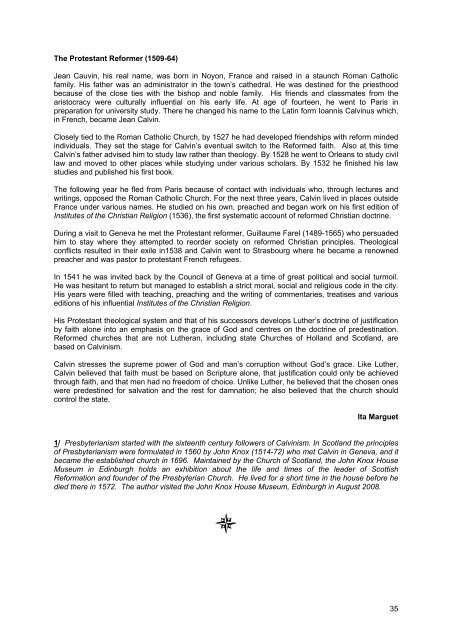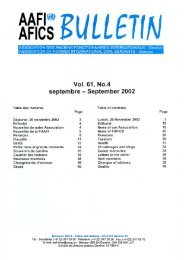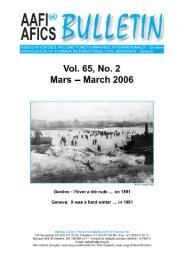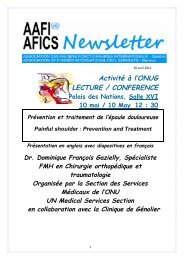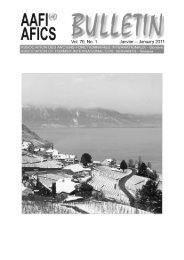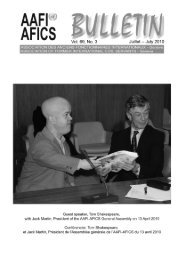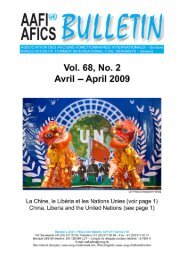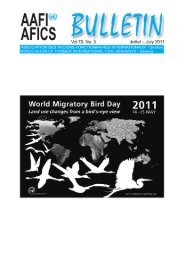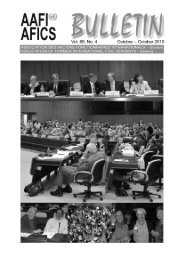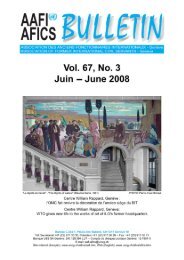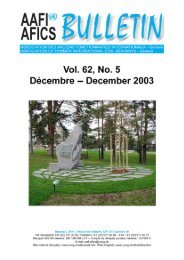pensions - AAFI-AFICS, Geneva - UNOG
pensions - AAFI-AFICS, Geneva - UNOG
pensions - AAFI-AFICS, Geneva - UNOG
- No tags were found...
You also want an ePaper? Increase the reach of your titles
YUMPU automatically turns print PDFs into web optimized ePapers that Google loves.
The Protestant Reformer (1509-64)Jean Cauvin, his real name, was born in Noyon, France and raised in a staunch Roman Catholicfamily. His father was an administrator in the town’s cathedral. He was destined for the priesthoodbecause of the close ties with the bishop and noble family. His friends and classmates from thearistocracy were culturally influential on his early life. At age of fourteen, he went to Paris inpreparation for university study. There he changed his name to the Latin form Ioannis Calvinus which,in French, became Jean Calvin.Closely tied to the Roman Catholic Church, by 1527 he had developed friendships with reform mindedindividuals. They set the stage for Calvin’s eventual switch to the Reformed faith. Also at this timeCalvin’s father advised him to study law rather than theology. By 1528 he went to Orleans to study civillaw and moved to other places while studying under various scholars. By 1532 he finished his lawstudies and published his first book.The following year he fled from Paris because of contact with individuals who, through lectures andwritings, opposed the Roman Catholic Church. For the next three years, Calvin lived in places outsideFrance under various names. He studied on his own, preached and began work on his first edition ofInstitutes of the Christian Religion (1536), the first systematic account of reformed Christian doctrine.During a visit to <strong>Geneva</strong> he met the Protestant reformer, Guillaume Farel (1489-1565) who persuadedhim to stay where they attempted to reorder society on reformed Christian principles. Theologicalconflicts resulted in their exile in1538 and Calvin went to Strasbourg where he became a renownedpreacher and was pastor to protestant French refugees.In 1541 he was invited back by the Council of <strong>Geneva</strong> at a time of great political and social turmoil.He was hesitant to return but managed to establish a strict moral, social and religious code in the city.His years were filled with teaching, preaching and the writing of commentaries, treatises and variouseditions of his influential Institutes of the Christian Religion.His Protestant theological system and that of his successors develops Luther’s doctrine of justificationby faith alone into an emphasis on the grace of God and centres on the doctrine of predestination.Reformed churches that are not Lutheran, including state Churches of Holland and Scotland, arebased on Calvinism.Calvin stresses the supreme power of God and man’s corruption without God’s grace. Like Luther,Calvin believed that faith must be based on Scripture alone, that justification could only be achievedthrough faith, and that men had no freedom of choice. Unlike Luther, he believed that the chosen oneswere predestined for salvation and the rest for damnation; he also believed that the church shouldcontrol the state.Ita Marguet1/ Presbyterianism started with the sixteenth century followers of Calvinism. In Scotland the principlesof Presbyterianism were formulated in 1560 by John Knox (1514-72) who met Calvin in <strong>Geneva</strong>, and itbecame the established church in 1696. Maintained by the Church of Scotland, the John Knox HouseMuseum in Edinburgh holds an exhibition about the life and times of the leader of ScottishReformation and founder of the Presbyterian Church. He lived for a short time in the house before hedied there in 1572. The author visited the John Knox House Museum, Edinburgh in August 2008.35


